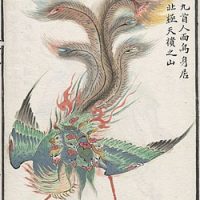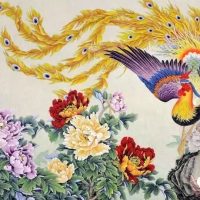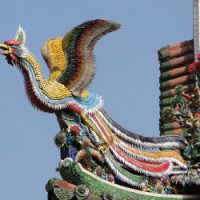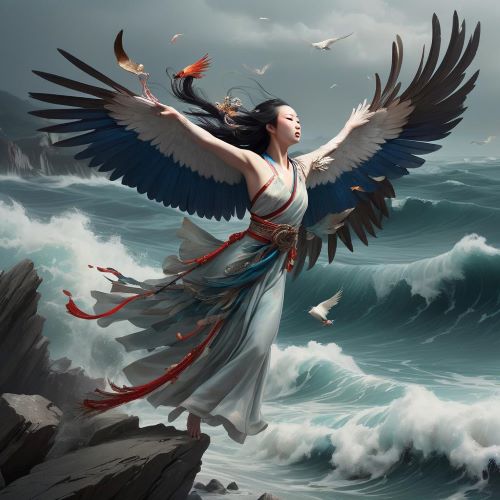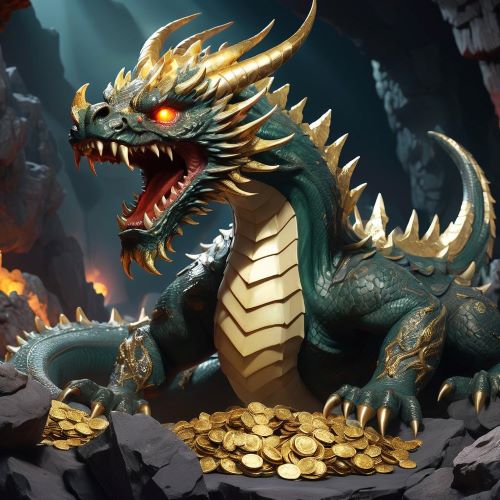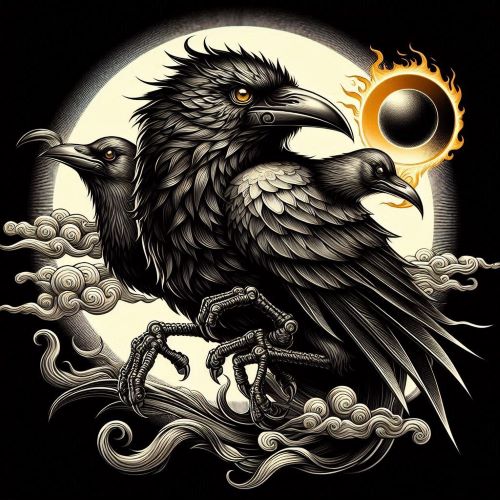Fenghuang: The Chinese Celestial Bird of Harmony
Listen
At a glance
| Description | |
|---|---|
| Origin | Chinese Mythology |
| Classification | Animals |
| Family Members | N/A |
| Region | China |
| Associated With | Rebirth, Renewal, Harmony |
Fenghuang
Introduction
The Fenghuang stands among the most revered figures in Chinese mythology, often introduced to the world through the simplified label “Chinese Phoenix,” yet its identity is far older and far more layered. Instead of symbolizing fiery rebirth, the Fenghuang represents moral excellence, cosmic equilibrium, and the promise of an era guided by wisdom and justice. Early depictions stretch back to Neolithic China, with images etched on jade artifacts and pottery long before the rise of dynastic rule. Over time, the Fenghuang became inseparable from imperial symbolism, especially in its association with the empress, acting as the feminine counterpart to the emperor’s dragon. Its appearance—real or legendary—was thought to mark the beginning of a golden age, making it a creature not of destruction and renewal, but of clarity, harmony, and celestial approval.
Physical Traits
The Fenghuang’s physical form is described as a breathtaking blend of several creatures, each chosen for its symbolic depth. Classical texts like the Shan Hai Jing and the Erya describe its beak as resembling that of a rooster, its face shaped like a swallow, its forehead broad like a fowl’s, while the neck curves elegantly like a serpent’s. The bird’s chest mirrors a goose, its back curves like a tortoise shell, its hindquarters align with a stag’s, and its sweeping tail resembles either a peacock’s feathers or flowing fish fins. This extraordinary composite body reflects its role as a ruler among birds.
Its feathers shimmer in five brilliant colors—red, yellow, blue, white, and black—each representing one of the Five Elements and Confucian virtues. Artists often portray the Fenghuang with celestial symbolism embedded into its form: the head corresponds to the heavens, the eyes to the sun, the back to the moon, the wings to the wind, the feet to the earth, and the tail to the orbit of planets. Rarely depicted as aggressive, it is shown either soaring above clouds or resting peacefully in paradisiacal landscapes, emphasizing its elegance and divine origin.
Family
In the earliest myths, the Fenghuang appeared not as a single being but as two complementary birds—Feng, the male, and Huang, the female. Their pair represented the eternal harmony of yin and yang, an equilibrium regarded as essential for a stable and prosperous world. As mythological literature evolved, the two merged into one entity known simply as Fenghuang, eventually interpreted as predominantly feminine due to its association with gentleness, virtue, and the empress. In imperial symbolism, the dragon and Fenghuang became the ultimate cosmic couple, embodying the perfect partnership that upholds the empire. Their union was invoked in weddings, official ceremonies, and courtly art, reinforcing the belief that prosperity emerges only when masculine strength and feminine grace coexist in balance.
Other names
While “Fenghuang” remains the most accurate term, the creature is known across cultures under different names. In English it is often labeled the “Chinese Phoenix,” a comparison that highlights superficial similarities but overlooks the vast differences in origin and meaning. In the context of celestial guardians, some classical references ambiguously link it with the Vermilion Bird (Zhuque), though the two are separate beings with distinct cosmological roles. Across East Asia, it appears as Hō-ō in Japan, Bonghwang in Korea, and Phượng hoàng in Vietnam, each adapted into local mythologies while retaining its core attributes of virtue, sovereignty, and auspicious beginnings. These wide-ranging interpretations reveal how deeply embedded the Fenghuang is in the cultural consciousness of the region.
Powers and Abilities
The Fenghuang is not a creature of physical combat; its power comes from its embodiment of moral and cosmic order. Ancient accounts state that it appears only during times governed by virtuous rulers, making its very presence a divine endorsement. It is believed to possess the ability to dispel evil influences, attract prosperity, and restore balance during periods of uncertainty. Its movements are said to create music so pure that it harmonizes the hearts of all living beings. Rather than rising from ashes like the Western phoenix, the Fenghuang symbolizes continuity—an everlasting existence tied to cycles of peace and righteous governance. Its body is believed to represent the virtues rulers must uphold: virtue in the head, loyalty in the wings, propriety in the back, compassion in the chest, and integrity in the abdomen.
Modern Day Influence
In modern culture, the Fenghuang maintains a prominent place in art, architecture, and popular storytelling. It appears in traditional embroidery, especially on wedding dresses where it represents marital harmony, echoing its ancient partnership with the dragon. Palaces, temples, and ceremonial items frequently bear its image, projecting status, refinement, and an aspiration toward moral leadership. In literature and cinema, the Fenghuang often appears as a guardian spirit or celestial companion, symbolizing resilience, hope, and transcendence. In addition, the historic town of Fenghuang in Hunan Province serves as a cultural landmark, attracting visitors drawn to its preserved architecture, folklore, and the mythic aura tied to the bird’s name. Its presence in modern branding, digital art, and global entertainment reflects how the Fenghuang has evolved from an ancient omen into a timeless emblem of balance and beauty.
Related Images
Source
Britannica. (2025). Fenghuang | Phoenix, Bird-Woman & Immortality. Retrieved October 2, 2025, from https://www.britannica.com/topic/fenghuang
Wikipedia. (2003). Fenghuang. Retrieved from https://en.wikipedia.org/wiki/Fenghuang
Study.com. (2020). The Phoenix vs. Fenghuang Bird | Mythology & Meaning. Retrieved October 21, 2020, from https://study.com/learn/lesson/fenghuang-vs-phoenix-meaning-in-chinese-m
MythologyCrafts. (2022). The History of Fenghuang and DIY Chinese Phoenix. Retrieved January 30, 2022, from https://mythologycrafts.com/the-history-of-fenghuang/
Life as Myth. (2006). The Chinese Phoenix. Retrieved December 31, 2006, from https://lifeasmyth.com/chinesephoenix
IJLLL. (n.d.). Fenghuang and Phoenix: Translation of Culture. International Journal of Law, Language & Literature, 11(3). Retrieved from https://ijlll.org/fenghuang-and-phoenix-translation
Yang, L. (2005). Handbook of Chinese Mythology. Oxford University Press.
Birrell, A. (1993). Chinese Mythology: An Introduction. Johns Hopkins University Press.
Wu, K. C. (1982). The Chinese Heritage. Crown Publishers.
Eberhard, W. (1986). A Dictionary of Chinese Symbols: Hidden Symbols in Chinese Life and Thought. Routledge.
Schafer, E. H. (1963). The Golden Peaches of Samarkand: A Study of T’ang Exotics. University of California Press.
Frequently Asked Questions
What is the Fenghuang in Chinese mythology?
The Fenghuang is a mythological bird symbolizing virtue, balance, and auspicious rule, often associated with the empress and cosmic harmony.
How is the Fenghuang different from the Western phoenix?
Unlike the phoenix, which symbolizes rebirth through fire, the Fenghuang represents peace, moral purity, and the balance of yin and yang.
What does the Fenghuang look like?
It is described as a composite bird with features of several animals and feathers in five sacred colors representing Confucian virtues.
What powers does the Fenghuang have?
The Fenghuang is believed to bring prosperity, dispel evil, and appear only under righteous and prosperous rule.
Is the Fenghuang still important today?
Yes, it remains a major cultural symbol in art, fashion, architecture, weddings, and modern media across East Asia.




